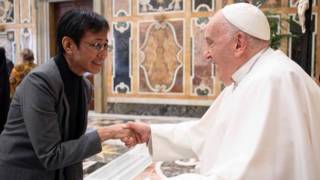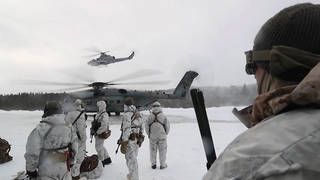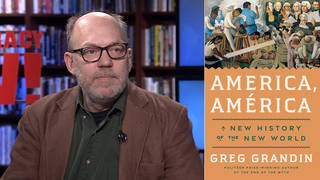
The Ukrainian government says about 100 people have been able to evacuate the besieged steel plant in Mariupol, where thousands of civilians and fighters have taken shelter in recent weeks as Russian forces took over most of the strategic port city. This comes after several previously arranged “humanitarian corridors” fell apart. Meanwhile, U.S. House Speaker Nancy Pelosi became the highest-ranking American official to visit Kyiv, days after President Joe Biden asked Congress for an additional $33 billion in military and humanitarian aid for Ukraine. For more on the war in Ukraine, now in its 10th week, we speak with Norwegian Refugee Council head Jan Egeland, who has been visiting Ukrainian cities “devastated beyond belief” by the Russian invasion. “I don’t think the world has understood enough that this suffering will become even deeper, especially in the east and the south, if the war is allowed to rage on like now.” Egeland says the only way to end the war is through talks, and warns against an “arms race” that could continue to fuel the conflict.
Transcript
AMY GOODMAN: This is Democracy Now!, The War and Peace Report. I’m Amy Goodman.
We end today’s show in Ukraine. House Speaker Nancy Pelosi became the highest-ranking U.S. official to visit Ukraine over the weekend, days after President Biden asked Congress for an additional $33 billion in aid for Ukraine.
Meanwhile, the Ukrainian government says about a hundred civilians have been able to evacuate the besieged Azovstal steel plant in Mariupol after the United Nations helped establish what it described as a safe passage operation. This comes as hundreds more civilians and many fighters remain trapped at the plant and elsewhere in Mariupol. Shelling is continuing today.
For more on the humanitarian crisis facing Ukrainians, we’re joined by Jan Egeland, secretary general of the Norwegian Refugee Council. He was just in Lviv, Kyiv, Ternopil, as well as Bucha, where he visited the site of a mass grave of murdered civilians.
Jan Egeland, welcome back to Democracy Now! Can you talk about what you found this time? You were only recently in Ukraine, and then you returned. Why don’t you start in Bucha?
JAN EGELAND: Bucha is totally devastated. It was a beautiful little town just north of Kyiv. I was there. I was in Irpin. I was in Borodyanka. These were suburban towns where there were a lot of gardens, a lot of parks, beautiful places. Now they are devastated beyond belief. For me, it’s like Syria, where, again, there are entire towns that now look like Stalingrad and Dresden looked in 1945. This war is raging in a way we haven’t seen in a long time. It’s urban warfare. And it’s devastating the lives of millions of people.
AMY GOODMAN: So, did you actually see a mass grave in Bucha?
JAN EGELAND: Well, we were where, on the very place — it’s just outside of a church — where they found the largest mass grave in Bucha. Those bodies had, thankfully, now been excavated and have been placed elsewhere. They have also been subject to forensic investigations, so that there can be evidence for potential war crimes trials in the future. Bucha is the place where perhaps they found the most bodies in places like where I visited, but also the other towns have had a lot of human — loss of civilian human lives.
AMY GOODMAN: And as we speak, in Mariupol, you have perhaps a hundred people have been able to get out of the Azovstal steel plant, making their way to Zaporizhzhia, but there are many hundreds more, both civilians, wounded fighters, both in the plant and outside of that. Reports are that 90% of Mariupol is destroyed. You’re the head of the Norwegian Refugee Council. Can you talk about the crisis there and the other places that you went to?
JAN EGELAND: Well, Mariupol has been now besieged for nearly two months. Besiegement means basically that you encircle a place, and you do not allow anything to get in, in terms of supplies to the people who are starving inside, and you do not let the civilians or others escape from the besieged place — which means suffering, again, beyond belief. There were children in these basements for very many weeks. They didn’t see daylight. They were awake all night, night after night, because of the constant shelling.
What I fear is that this will happen now with many more towns, cities in the east and in the south of Ukraine, where the battle is now raging. In Bucha, Irpin, Borodyanka, where I visited and where the Norwegian Refugee Council is starting relief work, the Russian forces have withdrawn. They have intensified their attacks in the east and the south, which, again, means that militarily cities will be encircled. And when they are encircled, there may well be besiegement, which, again, means that a place like Severodonetsk, where NRC had our headquarters in east before the invasion, that place, which is now 80, 85% destroyed — Mariupol, maybe 90% destroyed. So, it’s, again, a destroyed city, but not yet under besiegement. That place may also be under besiegement. I don’t think the world has understood enough that this suffering will become even deeper, especially in the east and the south, if the war is allowed to rage on like now.
AMY GOODMAN: You’ve said that hundreds of thousands of older adults, of senior citizens, are trapped in Ukraine’s east. Younger people are more able to move, but many people in their seventies and eighties and beyond, some of whom have disabilities, can’t move. Describe what is being done.
JAN EGELAND: That is the very nature of the east, where the battle is now raging with an enormous intensity. I visited the east just before the invasion, at the beginning of February, and I was really struck by a war zone where not, as it normally would be, from Afghanistan to Somalia to Congo to across the Middle East, Africa and elsewhere, the majority are children. These are young populations, 50%, 60% children. In the east, where I was, there were areas where 60% was 60 years and older, a lot of them miners, retired miners, the widows of retired miners. The younger population had already left and gone west because of the downturn of mining and industrial work.
Now a lot of the families who remain with children have fled, but the elder people, they stayed behind. I asked several of these elderly women, for example, that I met in small villages along the then-frontline, “Why aren’t you leaving?” And they answered with one voice, really, “We cannot leave. Where should we go?” One woman described how she had two sons, one in Moscow, one in Kyiv. You know, “Where would I go? This is my home. I will stay no matter what.” And the media is not able to cover what happens there, because it’s in the middle of the crossfire. But the elderly people are still there.
AMY GOODMAN: President Biden has asked the U.S. Congress to give $33 billion more. It will overwhelmingly go to military weapons, presumably, some humanitarian aid. Can you talk about how you see this war ending and the polarization on the U.N. Security Council? What needs to be done now, Jan Egeland?
JAN EGELAND: Well, it’s not going to end through an arms race, on either side. It’s going to end with talks at the negotiating table, where minority issues and Ukrainians’ relations to foreign military alliances and so on can be discussed. And to enable those discussions, it will end by a ceasefire, where the Russians, that are attacking, agree to generalized ceasefire, that could also enable our humanitarian work to reach all people and civilians to be able to — those who want to leave, that they can leave. Then the diplomats should sit down and agree on the bargaining table the future of the two neighbors, Ukraine and Russia. It’s not going to end with an arms race between the West and Ukraine, on the one side, and Russia, on the other.
AMY GOODMAN: And your thoughts on your neighbors, Sweden and Finland, possibly joining NATO?
JAN EGELAND: Well, they are going to decide, both countries, very soon whether they want to join NATO. Norway has been a member since the initiation of NATO. It’s, of course, paradoxical how the invasion of Ukraine has really bolstered Europe in its opposition to this.
We’re humanitarians. We’re neutral, impartial, independent. We are in a race against the clock to reach the people in the south and in the north and in the east, especially, of Ukraine. At the moment, we need more resources to win that race against the clock, but we also need agreements, humanitarian pauses. Humanitarian pauses are much better than humanitarian corridors, which are too fragile agreements to really be workable. Generalized humanitarian ceasefires is the best. We need it desperately.
AMY GOODMAN: And can you talk about the diversion of the crisis of humanitarian funding needed in other places, whether we’re talking about Burma, Yemen, Palestine, South Sudan? How are these being affected by the amount of money and the fighting in Ukraine?
JAN EGELAND: They are really affected more negatively than the world has understood, in three ways — first, because all attention and a lot of the resources are now going to this tremendous war in the middle of Europe. Thirteen million people now have been displaced. It is sucking up all attention and all resources.
Secondly, this is a war in the grain chamber of the world. Ukraine and Russia, these areas have really furnished African countries, Middle Eastern countries with the majority of their grain. The prices are going through the roof now, so the Somalis have to be in a bidding war for the remaining grain in the world with rich countries like Norway or the United States.
Thirdly, this war has made another Cold War between Russia and, to some extent, China and the West, which means that — you know, how can we get agreements on Syria and Yemen and so on in the Security Council, where there’s now going to be a stalemate and no cooperation between the great powers? It’s very, very worrying, far beyond Ukraine.
AMY GOODMAN: Five-and-a-half million Ukrainians have left the country. Millions have moved within the country. What is the most critical need right now?
JAN EGELAND: The most critical need now is to get enough resources to those who are closest to the battle. We, NRC, we were able, just as I visited a few days back, to get out 6,600 boxes with food to bomb shelter, to collective centers in Luhansk and Donetsk. I fear some of those people will be unreachable next week because of the battle.
Secondly, we need to — in addition to get the pure, you know, emergency relief to the frontlines, we need to get cash in hand to Ukrainians who are fleeing and who have no — have exhausted all of their resources. We’re also making progress there with funding from the United States and many other countries. We’re now able to transfer small amounts of money each month to families that have lost everything. Often these are mothers and children fleeing, whether in central or western Ukraine or in Poland and other neighboring countries.
AMY GOODMAN: Jan Egeland, I want to thank you for being with us, secretary general of the Norwegian Refugee Council.













Media Options